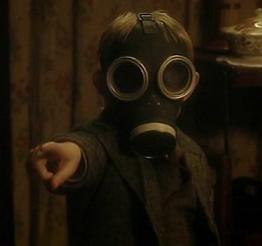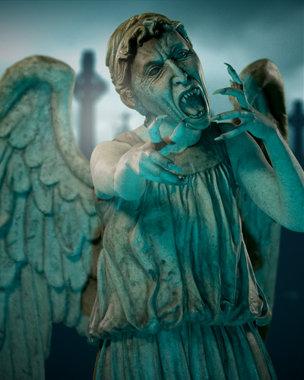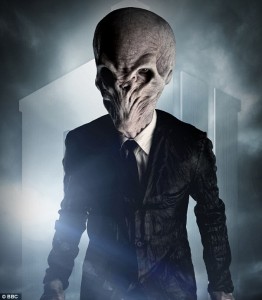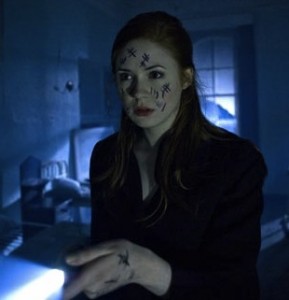Silence will fall — cleverly
The venerable but spry British science fiction television series “Doctor Who” has returned for another season – and judging by the opening pair of episodes, it’s going to be a doozy. Not, however, a doozy for the uninitiated.
The man responsible for the current season of Doctor Who is Steven Moffat, a British writer behind such British series as “Press Gang,” “Joking Apart” and “Coupling.” I haven’t seen any of them. What I have seen of him is his work as a writer and producer on Doctor Who, and the three-part “Sherlock” series he co-created (with another Doctor Who writer, Mark Gatiss). And from that corpus, the one thing you can say about Moffat is that he’s clever.
Even coming from me, “clever” isn’t an unambiguous compliment. It’s not the same as intelligent, though Moffat is that most of the time, too. By clever I mean that Moffat’s a fan of intricate plots, twists you don’t see coming but which in hindsight were telegraphed well in advance, writing that makes the audience scramble to catch up. You can see why he’s such a good fit for a modern-day revival of Sherlock Holmes, since Arthur Conan Doyle’s mysteries featured all those elements.
In Doctor Who, though, Moffat gets all the tools of science fiction to play with – and science fiction is even better territory than detective fiction for someone who wants to be clever.
Before taking over the Doctor Who franchise last year, Moffat was primarily a writer for the show, contributing a single story per season – and it was, accounting for taste, generally the best story of that season.

By the standards of his later concepts, Moffat’s first Doctor Who story almost seems pedestrian. In “The Empty Child” 2005 two-part story, he mixed in zombie movie tropes into science fiction in a tale of a mysterious virus that turned everyone who came in contact with it into a gas mask-wearing automaton, creepily repeating, “Are you my mummy?” Mysteries about identity of the boy Jamie (apparently Patient Zero of the virus), the vagabond Nancy and the over-suave time traveller Captain Jack Harkness all converged in the end to be crucial to the grand plot’s resolution, while along the way Moffat gave plenty of time for character moments and witty repartee.
All told it was grand, epic fun. When I’ve introduced someone in the past to Doctor Who, I show them enough episodes to convey the basic details of the show and then skip to “The Empty Child,” knowing it will seal the deal. I’m not the only one to appreciate this episode so much – it won a Hugo Award, and fans at “Doctor Who Magazine” voted it the fifth-best story in the show’s entire 30-season (at the time of the poll, 32 now) history.
In the next year’s series, Moffat contributed a much less epic story – but one that ramped up the clever-meter a few notches. “The Girl in the Fireplace” saw the Doctor stumbling across a deserted space ship littered with windows and doors leading into 18th Century France – and particularly into the life of the future Madame de Pompadour. The central conceit in the episode was that time passed at different speeds between the ship and the past. Step away from the time-window for five seconds and six months pass for Madame de Pompadour. The resolution of a monster-of-the-day threat from some clockwork automatons seems beside the point – Moffat’s real interest is the chronologically asynchronous relationship between the Doctor and Madame de Pompadour, as he pops in and out of her life over vast intervals. He liked this idea so much he’d reuse it in the future.

Moffat’s tour de force, however, would come the next year with “Blink.” It’s his signature bit of writing, and his best – and this being Moffat, that means it’s one of the best episodes ever. (The fan survey mentioned above rated is #2 in the show’s entire history, and the best episode since Doctor Who was revived in 2005.) Even better, it’s one of the rare episodes of this immensely complex and long-running series that can be happily watched by complete neophytes, since it’s from the point of view of someone (played by a then-unknown Carey Mulligan in one of her first major roles) who’s equally oblivious about the Doctor.
Two factors combine to make the story of “Blink” superlative. The first are the Weeping Angels, the story’s villains who transcend the “monster-of-the-day” trope to become instant classics. Over 32 seasons, Doctor Who has featured many different villains, many of them forgettable. Even the best are fairly repetitive: the famous and iconic Daleks are mutants in invulnerable conical battle tanks who want to exterminate you. The Cybermen are robotic humans who want to enslave you. The Sontarans are potato-faced clones who want to kill you. The Master is a suave alien who wants to enslave you.
The Weeping Angels are unique in more ways than one. Their concept builds off quantum mechanics and its insights into subatomic motion, where you can either know the location or momentum of a particle but not both, because the act of observation changes one or the other. The Weeping Angels, the Doctor explains, are “quantum locked” – they can only move when they’re not being observed. Look at them, and they appear to be a simple stone statue. Look away – even for the split second of the titular “blink” – and they can move until you observe them again.
Take your eye off them for too long, and they get to do what they want to – touch you. But rather than kill you, the Weeping Angel’s touch sends you back in time – to a fixed point in time, different for each one. The idea is they feed off the aborted potential of your normal life, while you live out your days in the past. They’re “the only psychopaths in the universe to kill you nicely.”
The second aspect of “Blink” that makes it such a great hour of television has to do, again, with time. The Doctor, touched by a Weeping Angel and sent into the past, reaches out across time to influence events 40 years in the future. Mulligan’s character, Sally Sparrow, has to find a way to defeat the Weeping Angels, and her only information comes from an eerie video recording of the Doctor carrying on one side of a conversation. The attempts of the protagonists to interact with the Doctor’s comments from 40 years ago definitely comes off as Moffat-being-clever – and it’s great.
In 2008, Moffat wrote his fourth Doctor Who story, and this was chock full of clever – the point that for some people, it started to wear a bit thin, even as they appreciated that Moffat was still the best writer Doctor Who had going. In the “Silence in the Library” two-parter, Moffat threw out a couple of different bits of cleverness:
-
A character, Professor River Song, who knew the Doctor very well – but he didn’t know her at all. In a bit inspired by “The Time Traveler’s Wife” (which I haven’t read), the River-Doctor relationship was established as two people who keep meeting out of order. This was a return to the idea Moffat introduced in “The Girl in the Fireplace,” but where that story was about two peoples’ lives moving by at different speeds (an hour for the Doctor, a lifetime for Madame de Pompadour), this is about two peoples’ lives moving in different directions.
-
A close focus on memory and consciousness, including communicators embedded in the nervous system that stored a “ghost” of the person’s consciousness and continued to speak for a few minutes after that person died
-
Some bits I won’t spoil dealing with memory and consciousness again, as well as the impact of choices
Shortly after “Silence in the Library,” Moffat became the Doctor Who showrunner, taking over from Russell T. Davies (of “Queer as Folk”), who had revitalized the series after a decade and a half off the air. Now instead of just writing an episode per season, he’d write 3-4 per season and supervise all the other episodes, including imposing a larger seasonal story arc.
Where Davies’ tendencies ran towards relationship-based melodrama and enormous set pieces involving aliens threatening the entire human race, Moffat as executive producer had a more whimsical approach, even when dealing with serious subject matter. He also introduced a slightly more serialized approach to the season – under Davies there would be a recurring motif (such as the 2005 season continually repeating the phrase “Bad Wolf”) but each episode generally stood on its own and the “big bad” of the season wasn’t revealed until the final episodes. Moffat, in contrast, introduced the big threat (mysterious “cracks in time”) in episode 1 and lingered on them all season, including making the cracks in time important plot points throughout.
In the multi-part season finale, Moffat delivered a paradox-defying climax that showed off one of his more admirable tendencies as Doctor Who showrunner. The Doctor’s time machine, the TARDIS, is often used as little more than a device to move from one setting to the other. The Doctor travels to the past or the future or to another planet, gets out, has his adventure, and gets back in. Under Moffat, time travel plays a part in the plots – even at the risk of those paradoxes I mentioned. A character gets bailed out a tough situation, and immediately travels back in time to set up the circumstances by which they were bailed out.
You can see what I mean by clever. Moffat’s constructions can easily collapse on themselves if you spend too much time thinking about him. But what makes him a good writer – and raises him about the usual Hollywood time travel treatment – is that he’s good enough to pull it off. Most of the time, anyway.
There’s plenty of clever going on in “The Impossible Astronaut,” one of the more fascinating Doctor Who stories I’ve seen. It starts off with an incredibly significant event just a few minutes in. The final shot of the second part of the episode is another incredibly significant image for the show’s plot and characters. I said at the top that it’s a great episode but a terrible place to start, and I stand by that – if you’re not familiar with the characters and their situation, what happens to them in this episode is not going to mean very much.
In part, Moffat is liberated by NOT having to do introductions. From 2005 through 2010, each Doctor Who season had either a new “companion” traveling with the Doctor or a new actor playing the Doctor (who, as an alien Time Lord, has the convenient ability to regenerate into a new body after dying). So the first episode of each previous series had to introduce viewers to a new character or two. In contrast, for this season, the same actor (Matt Smith) and same companions (characters Amy Pond, Rory Williams and occasionally River Song) as the previous series, so Moffat can jump right in and start messing with their lives.
Moffat leaves all SORTS of things unresolved even after two hours, setting up the entire season. It’s basically impossible to blog about the plot much without getting into spoilers, which I won’t do out of courtesy to the uninitiated.
What I will reveal is that the plot hinges on two different versions of the same character, one older and more experienced than the other, both getting involved in the action – but not, as far as we can tell, at the same time. It’s a great shock to the characters and to us when Version 2 strolls in insouciantly, lacking the same memories and experiences of the older version.

That point is important in discussing the memorable villains of the episode, The Silence. If you’ve read through my discussion of Moffat’s previous work, you’re in a good spot to appreciate them.
The Silence are first introduced as an alien figure in the distance, witnessed by companion Amy Pond – and then immediately forgotten as she looks away. They wear a leathery-looking suit over a shirt and tie, but have a bulbous head (modeled after “The Scream”) and long pointed fingers, with greyish skin.
Soon enough things become explicit: the Silence have the particular ability that you can only remember them when you’re looking at them. Look away and the memory vanishes. Even the Doctor is subject to this.
Does something exist if you can’t remember it? It’s a variation on the old “tree falling in the forest” question. Moffat doesn’t allow this philosophical query to linger too long, though, before introducing another Silence power – when you look away and forget them, any orders they gave to you linger, like post-hypnotic suggestions. They’re not simply observers flitting in and out of existence depending on whether they’re observed, but controllers, manipulators – parasites, who don’t produce anything for themselves but rather make their unwitting hosts, humanity, provide it for them.
It’s a fascinating inversion on the Weeping Angels concept. The Angels’ existence also depended on being observed; in their case, that locked them in place. Looking away freed them to move. The Silence exist, essentially, only when you observe them, leaving only an after-effect in their suggestions when you look away.

Where “Silence in the Library” dealt with the persistence of memory, which endured even after death, “The Impossible Astronaut” takes up the transience of memory. How do you fight something you can’t remember? The protagonists try all sorts of methods – photographs, audio recordings, and most eerily drawing tally marks on their skin with permanent marker every time they see one, so they’ll know later to look for something.
Even though in the final moments of the episode the Silence appear to be defeated, we clearly haven’t seen the last of them. They’ve also been foreshadowed for a long time. Fans online quickly dug up video clips from last year where characters seemed to react to something, then look away and forget they had just seen something. And one episode hinged on a mysteriously abandoned alien spaceship – and only in “The Impossible Astronaut,” when we see one of the Silence’s spaceships, do we realize it was one of theirs.
That’s not even touching on the curious little girl in the astronaut suit and her relations to the Doctor and to Amy Pond, and the long-teased moment when River Song will do something horrible to the Doctor – something she remembers doing in some of her experiences, but which lies entirely in the Doctor’s future.
There’s a lot of things in the air. And in “The Impossible Astronaut,” Moffat keeps the juggling act going by sheer cleverness. There’s so many layers upon layers interacting that it could all fall apart. That it hasn’t – and hopefully will continue not to – is a testament to Moffat’s ability to combine clever writing with intelligent writing. Doctor Who’s past is full of intelligent episodes that weren’t particularly clever – witty dialogue and a weighty theme layered over a straightforward adventure. There’s also episodes that were clever without being terribly intelligent – a gimmicky, hollow plot, poorly executed.
“What were you doing to Apollo 11?” “A thing. A clever thing. Now. No more questions. You have to trust me.”
How long can Moffat keep the juggling going? At a certain point in time you expect even the cleverest of writers to run out of ideas. Now that Moffat’s much more heavily involved in Doctor Who from his old one-episode-per-season days as a writer, he’ll hit that point that much more quickly. In the previous season I observed that while the general quality was improved, there weren’t the same superlatively stand-out episodes as there had been in the more uneven days of Russell T. Davies. Moffat wrote a few episodes, but they were – by his standards – relatively pedestrian, at least until the finale. There was no “Blink,” no “The Empty Child,” nothing that will top any fan polls years from now.
Bu with a full season under his belt, Moffat seems to be shooting for the stars now. “The Impossible Astronaut” was a HIGHLY ambitious story, one executed well even if so many events were left frustratingly unanswered. As a fan of the show, I’m looking forward to what cleverness Moffat comes up with next.